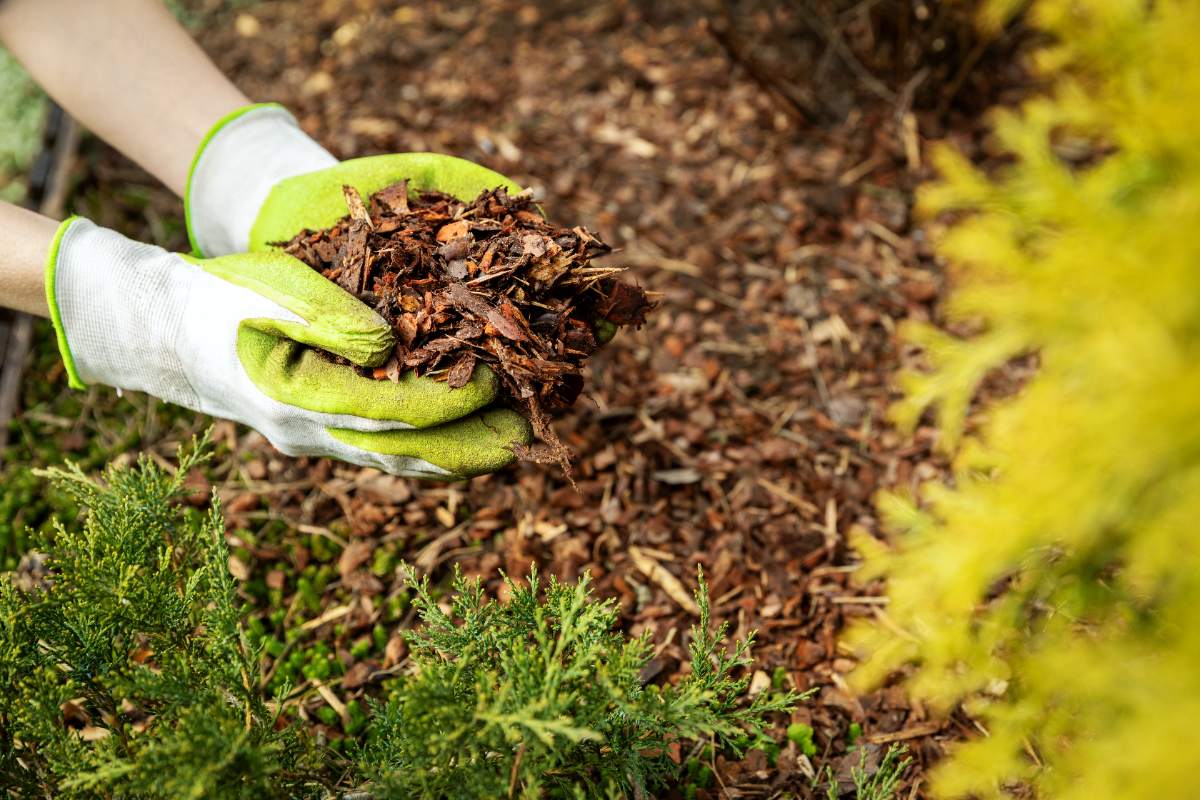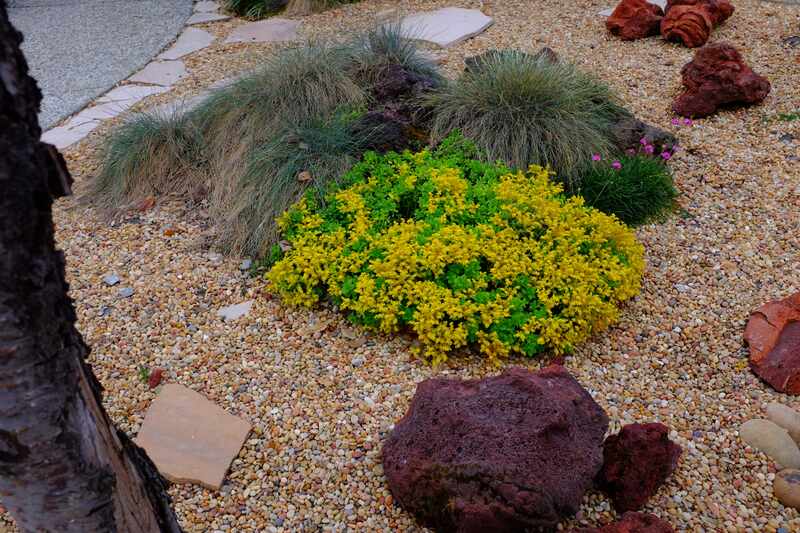
Generally, you should replace or refresh your organic mulch once a year. But how often you should replace mulch depends on what type you have and your local climate.
Organic mulches like straw and cocoa hulls last 1 to 2 years, while some inorganic options like gravel can last 10 years or more. We’ll give you a complete rundown to help you keep your flower bed or garden at the top of its game.
| If you need someone to help you choose and spread mulch on your flower bed, contact our landscaping pros. Our customers spend around $286 for mulching services and rate our pros at 4.7 out of 5 stars. |
Mulch Replacement Schedule by Type
Knowing how often to replace your old mulch is half the battle when preventing weeds in your flower bed or garden. Typically, inorganic mulches last from 5 to 10 years, while organic mulches should be replaced every 1 to 2 years.
| Mulch | Mulch Type | Replacement Schedule |
| Shredded wood/Wood chips | Organic | Once a year |
| Bark | Organic | Once a year |
| Straw | Organic | 1 to 2 years |
| Cypress | Organic | 2 to 3 years |
| Cocoa hulls | Organic | 1 to 2 years |
| Gravel/Stone | Inorganic | 10 years or more |
| Rubber mulch | Inorganic | 8 to 10 years |
Shredded Wood (Wood Chips)

- Replace once a year.
- Cost: Wood chips cost around $30 to $110 per cubic yard to be installed
Although not as nutrient-rich as mulched grass clippings, wood chips still do a good job insulating the soil and controlling weeds. Wood chips can come in different sizes, and the larger ones will usually last you longer. The type of wood also matters: Redwood and cedar chips take longer to decompose.
Lastly, you can also make sure your wood chips last longer by applying an appropriate amount. Make sure your mulch layer is 2 to 3 inches deep to optimize its lifespan. Check out our mulch calculator to figure out how much you need for your yard.
Bark
- Replace once a year.
- Cost: Bark mulch costs around $30 to $100 per cubic yard to be professionally installed.
Bark chips tend to break down faster than wood chips, especially when exposed to the sun and in moist environments. So depending on your local climate, you may need to replace it even twice a year. A 2- to 4-inch layer is the ideal depth, but remember to turn it over from time to time to prevent sogginess and clumping.
Bark and wood chips are suitable for both gardens and home landscaping, so some homeowners end up choosing based on color. See our guide on How to Choose the Right Mulch Color for Your Landscape for useful tips.
Straw
- Replace every 1 to 2 years.
- Cost: Straw mulch costs around $20 to $55 per cubic yard installed.
Pine straw or wheat straw mulch is on the cheaper side, and you can even get straw for free if you live near a farm. Just have in mind that it is highly flammable — cigarette tips and glasses or bottles that reflect sunlight can easily ignite this material.
For good insulation, spread a 2- to 3-inch layer of straw mulch. To make it last longer, thicken the layer until it reaches 4 inches. This is especially helpful if your area has heavy rains, wind, or if you struggle with soil erosion.
Take a look at our guide for instructions on mulching techniques for different areas: How to Mulch Your Yard: A Step-by-Step Guide.
Cypress
- Replace every 2 to 3 years.
- Cost: Cypress mulch costs around $110 per cubic yard for professional installation.
Cypress mulch is on the more expensive side for an organic mulch. Although costlier, if you’re looking for a durable organic mulch, cypress might be your best choice. It lasts at least 2 years in your landscape, having one of the longest lifespans of any organic mulch (along with cedar mulch).
To make it last on your landscape, avoid applying it too close to plant roots to discourage pests and plant diseases. Additionally, fluffing it up will improve airflow and prevent matting. To protect your mulch against rain and heavy wind, add edging around it to keep it in place.
Cocoa Hulls
- Replace every 1 to 2 years.
- Cost: Cocoa hulls will cost you around $40 for a bag that covers 1 cubic foot.
Cocoa hulls have become popular due to the delicious cocoa fragrance that permeates the yard once they’re applied. Cocoa mulch retains humidity, so avoid overwatering. A 2- to 4-inch layer of cocoa mulch is generally the ideal amount, since thick layers can lead to mold.
It is also important to apply where your pets don’t have access to it, since cocoa is highly poisonous to dogs. If you have pets, consider going for inorganic mulches instead.
See Related:
Gravel and Stone

- Replace every 10 years or more.
- Cost: Gravel or stone mulch costs anywhere from $50 to $180 per cubic yard to be professionally installed.
Lasting up to 10 years or more, gravel or stone mulch has the best longevity out of the organic and inorganic options in this list. Just remember that rock mulches trap heat easily, so avoid spreading gravel over heat-sentitive plants.
Maintenance is simple: Rake it occasionally to improve airflow and prevent bald spots. Use a leaf blower to get rid of debris. Edging is also a good strategy to keep your mulch in place if you deal with heavy rains or wind.
See Related:
Rubber Mulch
- Replace every 8 to 10 years.
- Cost: Rubber mulch typically costs around $80 to $140 per cubic yard if installed by a professional
Rubber mulch is made of recycled tires, lasting 8 to 10 years. Although very resistant against decomposition, pests, and wind, rubber mulch is also flammable and toxic for the environment. Consider the pros and cons of rubber mulch so you’ll know if it is the best option for your yard.
A low-maintenance option, rubber mulch can be cleaned with a soap solution and water (your garden hose works well) to remove ingrained dirt and grime. For loose debris such as leaves, twigs, and rocks, you can use a leaf blower. To extend its life, use weed barrier fabric underneath, and clean it at least once per year.
Regional Factors
Your local climate will impact how often you’ll need to refresh or replace mulch. Some environmental factors that impact mulch durability are:
- Rain increases humidity, which favors the decomposition process.
- Heat also speeds up the decomposition process, so homeowners in hot climates will need to replace mulch more frequently.
- Wind may shorten your mulch’s lifespan. If you live in a windy or storm-prone area, the high winds during storm season can end up blowing away your mulch easily.
See Related: 11 Hurricane-Resistant Landscaping Ideas
FAQ
Yes, you can add new mulch over old mulch if it is not compacted or matted. Either way, remember to lightly rake the old mulch layer before adding more to improve air circulation.
Professional mulch installation costs $77 to $94 per cubic yard. Typically, you won’t have to remove the old mulch before installing a new layer, but if you want a complete mulch removal, you’ll pay $50 to $75 per hour for this service and a disposal fee of $50 to $100.
The best time to spread mulch is typically in spring, before the weeds start to emerge. You can also spread mulch during early to mid-fall to prevent your plants from winter stress. Ideally, check your garden beds every spring to look for the signs you need to replace your mulch.
When to Call a Professional
Choosing the right mulch for your garden or landscape can be a confusing task. Consider contacting one of our local landscaping pros to help you out. That way, your flower and vegetable beds will look impeccable, and you’ll be free to spend your time as you see fit. Get in touch today.
Main Image: Pine tree bark mulch. Image Credit: ronstik / Adobe Stock